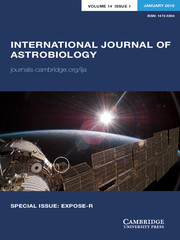Article contents
Provenance and age of bacteria-like structures on mid-Palaeozoic plant fossils
Published online by Cambridge University Press: 23 October 2006
Abstract
Structures, termed microbioids, comforming to bacteria in size and shape (e.g. rods, spheres, chains and clusters of spheres) have been observed by field emission scanning electron microscopy (FE-SEM) on coalified Silurian and Lower Devonian spores, sporangia, cuticles and coprolites. Some were sectioned for transmission electron microscopy. The elemental composition of both microbioids and ‘substrates’ was investigated using a X-ray microanalysis system. These analyses combined with comparative studies on recent bacteria and cyanobacteria were undertaken to evaluate the biogenicity, nature and age of the microbioids. Spheres with a Si signature (0.03–0.5 μm diameter) and assumed composed of silica are interpreted as artefacts produced abiotically during the extraction procedures. A similar origin is proposed for hollow spheres that are composed of CaF2. These occur singly, in short chains simulating filaments, and in clusters. Considerable differences in size (0.2–2.0 μm diameter) and appearance relate to local variation in the chemical environment during extraction. Spheres (0.2–1.5 μm diameter), that lack a mineral signature, with a framboidal surface ornament and occur within sporangia are identified as by-products of spore development. A biotic origin is also postulated for C-containing rod-shaped structures (>3.1 μm long, <1.4 μm wide), some with collapsed surfaces, although comparisons with living bacteria indicate recent contamination. More elongate rod-shaped microbioids (<8.6 μm long, 1.2 μm wide) have been identified as detrital rutile crystals (TiO2). Minute naviculate structures (<2.2 μm long) resembling diatoms are of unknown origin but are probably composed of thorium hydroxide. Unmineralized filaments of cyanobacterial morphology are recent contaminants. Some of the sporangia and spore masses are partially covered by associations of fragmented sheets, interconnecting strands, rods and spheres that are interpreted as dehydrated biofilms. Being unmineralized they are probably also of recent origin, although they might have survived wild-fire along with the charcoalified mesofossils. Many of the structures illustrated here were initially identified casually as bacteria on the small fossils extracted for biodiversity studies using well-tried, conventional, palaeobotanical techniques. Our subsequent more detailed analyses have shown how such processes can produce artefacts that are morphological analogues of mineralized bacteria, leave residues that mimic bacterial shapes and, despite some efforts such as storage in dilute HCl to eliminate living bacteria, introduce contamination. They reinforce previous concerns that verification of the biogenicity and syngenicity of bacterial-like objects in ancient Earth and extra-terrestrial rocks should not only rely on size and morphological look-alikes, but must encompass a thorough understanding of fossilization processes and extraction techniques plus, ideally, other measures of biogenicity (e.g. biomarkers) and syngenicity.
Keywords
- Type
- Research Article
- Information
- Copyright
- 2006 Cambridge University Press
- 9
- Cited by




